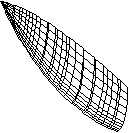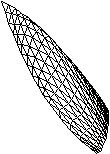




13. Hull for a boat (Example 1)
|
|
|
This exercise is designed to compare three methods of making a boat hull from the same set of curves. You will see differences depending on the method used because the surface is not skinned the same way; the first hull is the most rounded and the third one is the least.
|
|

1st method: Hull
|

2nd method: Coons
|

3rd method: Ruled Surface
|
Boat Hull 1 (1st method: Hull)
· Step 1: Construction drawing
q Tool: Drawing tool, Interpolated Curve
q Do this:
Draw 3 NURBS curves, each on a different plane:
Each curve must have a null dimension (x or y or z = 0) and each one must line on a plane: x,y (z=0), x,z (y=0) & y,z (x=0)
These curves make a closed shape.
q See the detailed explanations in the chapter:
User Manual/Tools/Construction/Drawing/ Interpolated Curve
|

|
q Tool: Hull
q Open the model file: Hull1
q Do this:
1. The example model looks like a half boat hull.
2. With the Hull tool, click first on the vertical curve, then on the two others.
A mesh is generated.
q See the detailed explanations in the chapter:
User Manual/Tools/Construction/Surfaces/Hull Tool
|

|
Boat Hull 1 (2nd method: Coons)
· Step 1: Surface generation
q Tool: Hull, Coons
q Open the model file: Hull1
q Do this:
From the same curves and selecting them in the same order as shown above, but with the Coons Hull tool, the result is a half hull also, but it is less rounded.
q See the detailed explanations in the chapter:
User Manual/Tools/Construction/Surfaces/Coons Surfaces
|

|
Boat Hull 1 (3rd method: Ruled Surface)
· Step 1: Surface generation
q Tool: Ruled Surface
q Open the model file: Hull1
q Do this:
Using only the two horizontal curves, and clicking the two ends not joined (delete the vertical curve), we still get a half hull, but tighter than with the two previous methods.
q See the detailed explanations in the chapter:
User Manual/Tools/Construction/Ruled Surface
|

|










